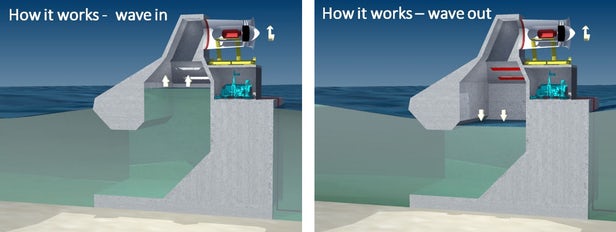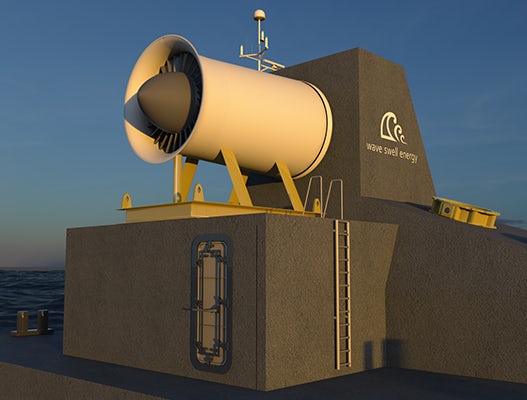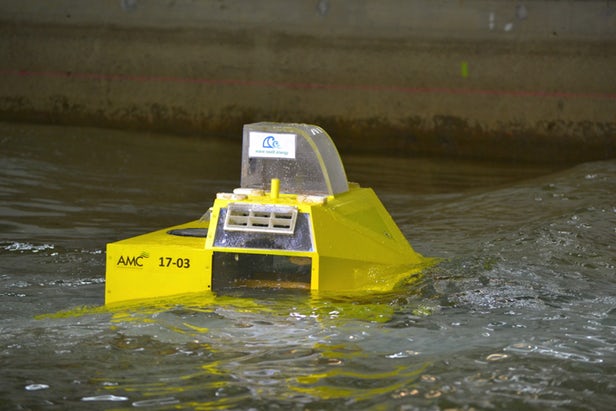Source: newatlas.com
Published: May 12, 2017

New Atlas spoke to Dr. Tom Denniss, the CEO of Wave Swell Energy, about the company’s new system designed to harvest electricity from ocean waves. Wave Swell Energy
Wind and solar power are becoming increasingly attractive alternatives to fossil fuels, but renewables are a rich tapestry, and the more threads we can weave together, the better. Ocean waves could be one such thread, and Australian company Wave Swell Energy is developing a new device to harvest that energy. New Atlas spoke to Dr. Tom Denniss, the CEO of the company, to find out about the technology.
With the Paris Agreement coming into force last November, almost 200 countries around the world pledged to fight to keep global temperatures from rising more than 2° C (3.6° F) above pre-industrial levels by the end of the 21st century. It’s an ambitious and crucial goal, and exploring and exploiting renewable energy sources will play a key role in achieving it.
2016 was a boom year for solar power, and renewables as a whole overtook coal to become the world’s largest source of installed power capacity. But nature isn’t easily tamed: wind farms and solar arrays are at the mercy of the elements, so the more diverse our renewable energy mix, the more reliable the power grids of the future will be.
The endless motion of the ocean is a great resource, and we’ve seen some creative methods to try to tap into that energy. Point absorber systems use a buoy to drive an underwater hydraulic system, while Gibraltar’s wave energy station is mounted onto a jetty, where it converts the rise and fall of waves into fluid pressure.

Wave Swell Energy’s system is based on the idea of an oscillating water column, where waves wash into a chamber and displace air, which spins a turbine to generate electricity. Wave Swell Energy
The Artificial Blowhole
Wave Swell’s device takes the form of a concrete column that sits in the sea, funneling waves in and out of a central chamber that results in air being drawn through an intake above the water’s surface to drive a turbine. The structure itself measures 20 m by 20 m (66 ft) around, and stands 18 m (59 ft) tall, although only 8 m (26 ft) of that protrudes above the water line, with no moving parts below it.
“It’s essentially an artificial blowhole,” explains Denniss. “So it’s like a cavern that’s open underneath the water, sealed at the top except for some valves and a turbine. What that means is that as the wave passes by the structure, water will flow into the cavern and rise inside. That displaces the air above, which gets vented out through a series of valves, and then when the wave starts to recede, those valves close. So the water wants to fall, and that creates a partial vacuum inside the chamber, and it sucks air back through past our turbine, and that’s what generates the electricity.”
That overall design is based on the concept of an oscillating water column (OWC), but there’s a key difference. Most of these systems “breathe” solely through the turbine, meaning it has to be designed to allow air to pass both inwards and outwards, at the cost of some efficiency. But with Wave Swell’s device, the outward air is expelled through the valves, meaning the turbine itself can be much simpler since it only has to deal with incoming air.
“An issue with previous oscillating water columns has been that the flow has been bi-directional,” says Denniss. “In other words, as the waves rise, it forces the air out past the turbine in one direction, then as the waves fall, the air gets pulled back past the turbine in a different direction. And so those turbines have had to cope with the bi-directional flow, generally by pitching their blades or by some other means which create very inefficient conversion. So what the valves allow us to do is create uni-directional flow, so the turbine can act much more efficiently. In reality, it simply acts a lot more like a conventional turbine, rather than a complicated bi-directional turbine.”
While it sounds somewhat passive, the device uses resonance to make the most energy out of the water that washes into it. The phenomenon can be seen in action in the video below, where the water inside the chamber is higher than the waves on the outside.
“What it does is it means we get the system operating at the natural frequency of the waves, and what happens is the oscillation of the water inside the chamber, the up-and-down motion of the water, gets amplified because it’s resonating at the same frequency as the waves,” says Denniss. “That’s crucial, it modifies the surrounding wave field and draws more energy in than would naturally be incident upon the device.”
That efficiency boost means the system’s peak output is rated at 1 MW, with an operating average of about 470 kW. That gives it a capacity factor – which is the ratio of the average power a system can generate to its peak – of about 47 percent, compared to the 30 percent that other wind and wave energy systems might manage. With that level of efficiency, the company claims its system should be able to produce electricity for a cost of about AU$0.10 (US$0.07) per kWh, which is roughly on par with coal.

Wave Swell Energy’s design is more efficient than other oscillating water columns, because of a unique design that allows its turbine to be uni-directional Wave Swell Energy
Fit for a King
Wave Swell Energy’s take on an OWC is set to be trialed off the coast of King Island, which lies between Tasmania and the Australian mainland. With a population of less than 2,000 people, the island is a testbed for renewable energy already. Several organizations are collaborating on a project that incorporates wind and solar energy to supply about 65 percent of the island’s power, and in 2015 the entire island was run off 100 percent renewable energy for 33 hours straight.
Like any renewable source, waves are intermittent, but when it’s combined with the solar and wind infrastructure already in place on King Island, the system can help patch some holes in the energy production. A goal of the team is to increase the amount of time that the small community can run fully on renewable energy.
“It’s really to supplement the power on King Island,” says Denniss. “What they’ll find using our technology there is that because we’re not particularly correlated with the wind, that means there’ll be times when the wind will be operating and we won’t, and vice versa, and sometimes when both are. And what it will also enable them to do is run the whole island completely off renewables for longer than they’ve ever done before. We would hope that with the incorporation of our technology into the island’s grid, they might be able to push that up to hundreds of hours. Because we’ll basically fill in a lot of the gaps that they have.”
So far, Wave Swell has completed the design phase of the project and developed a prototype of the system. A full-size unit is due to be up and running off King Island by mid-2018, and in future, the team hopes to set them up in other areas that could benefit from the technology.

Wave Swell Energy has developed a prototype of the system. Wave Swell Energy
Surfing in the USA
Hawaii is one possible target, according to Denniss. Due to its isolation, the island state’s grid is primarily powered by diesel, making electricity prices notoriously expensive – even though there’s a huge potential wave resource lapping the shores. Systems like Azura are already riding the waves out there, but again, it’s always the more, the merrier with renewables.
“Hawaii is the largest diesel-electricity market in the world,” says Denniss. “Most of their electricity is generated by diesel, and they pay a lot for that power. I think the real cost of generation of electricity in Hawaii is approaching US$0.40 a kWh, so it’s really very high. We could, I’m sure, produce power for well under what they currently have to pay for diesel-fired electricity.
“It’s not just the cost either. They’re desperate to wean themselves off their reliance on foreign oil. But also for reliability issues, and security of energy, because it only takes a bit of an oil shock in the world, and Hawaii could find themselves priced out of their ability to generate power. Or they may just be cut off altogether. It’s one thing to not be able to run cars when that happens, but it’s another to not have any power at all, for refrigeration and in hospitals.”
Wave Swell Energy plans to scale things up pretty quickly, and Denniss says he’d like to see projects on the scale of 100 MW or more up and running within the next five years. The larger the scale, the cheaper the energy becomes to produce, and in the long run, the team believes it will be possible to get the price down to about AU$0.05 (US$0.04) per kWh.
Source: Wave Swell Energy
